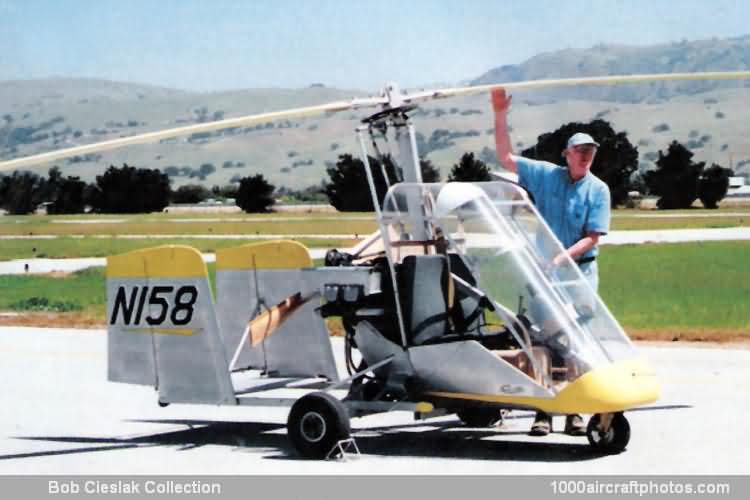The Sportster is suitable for pilot training and for flying on short cross-country journeys of up to 90 mls (145 km). It has been designed for towing behind a car, with the rotor stowed in a box attached to the car's roof. From the towed condition, the Sportster can be ready for its pre-flight walk-round inspection in ten minutes.
Design began in June 1969, and construction was started in December 1972. In 1973 Bob Cieslak photographed the aircraft under construction at Martin's home in Orlando, with Martin at the controls and viewed by Bob, and a year later how the HA-2M was towed by the VW Beetle.
Powered by a 130 hp Franklin Sport 4B flat-four engine and registered N158, the first flight was made in October 1974, with FAA certification in the Experimental category. Test flying was completed by January 1976.
The same year the prototype won a 'Best Original Design' award at the EAA Oshkosh meeting and an 'Outstanding New Design' award at the PRA Fly-in at Rockford. In 1977 it received the 'Best Autogyro' award at the EAA's Annual Antique Fly-in and air show at Watsonville, California.
The Sportster utilizes a collective pitch mechanism and a mechanical pre-rotator which engages the engine, via a c1utch, prior to take off to pre-spin the rotor to 230 rpm. This allows the aircraft to take off after a very short run. A rotor brake is utilized to slow down the rotor after landing and to stop the blades for taxiing.
More than 65 Sportsters have been under construction in the USA, Canada, New Zealand and Sweden, most of these are powered by an 150 hp Avco Lycoming O-320 engine, but Bob Grayson, living at a height of 6,500 ft (1,980 m) in Montana, selected an 160 hp Avco Lycoming and larger rotor blades. About a dozen Sportsters are still registered in the USA.
Prototype data:
Rotor diameter: 28 ft 0 in (8.53 m)
Length overall: 12 ft 0 in (3.66 m)
Height rotor head: 7 ft 8 in (2.34 m)
Rotor disk: 615.44 sq.ft (57.18 sq.m)
Weight empty: 620 lb (281 kg)
Loaded weight: 1,050 lb (476 kg)
Max speed: 90 mph (145 kmh) at sea level
Max cruise speed: 75 mph (121 kmh) at sea level
Econ cruise speed: 60 mph (97 kmh) at sea level
Stall speed: 28 mph (45 kmh)
Take off run: 350 ft (107 m)
Landing run: 0 to 20 ft (0 to 6 m)
Climb: 700 ft (213 m)/min
Service ceiling: 8,000 ft (2,440 m)
Range: 90 mls (145 km)."
